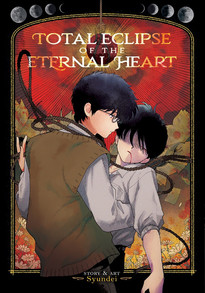Review
by Rebecca Silverman,Total Eclipse Of The Eternal Heart
GN
| Synopsis: |  |
||
In 1920, nine boys were murdered in Tokyo. Though the crime has long been forgotten, every night high schooler Terumichi dreams of the final killings, from the perspective of one of the boys involved. Already a loner with a single friend, Yamada, the dreams begin to eat at Terumichi. As he tries to learn why they're happening and reconcile his feelings for Yamada, the two pieces of his life begin to come together in ways both terrifying and somehow completely natural. |
|||
| Review: | |||
Some authors are one-trick ponies, churning out the same basic (possibly very enjoyable) story over and over again. Syundei is not one of them. Total Eclipse of the Eternal Heart is her second book to be released in English by Seven Seas, and it could not be more tonally different from the first, Go For It, Nakamura!. Where the latter volume is a cheery, silly tale about a boy trying to get up the courage to approach his crush, Total Eclipse of the Eternal Heart is a dark horror story about love and murder, set in both 1920 and 2017. Both stories share a BL element, but that's really about it. The story follows Terumichi, a high school boy who has never recovered from either the bullying he was subjected to in his younger years nor his father's rejection of how that bullying hurt him. Now fully an outcast at school, only one boy, Yamada, is willing to spend any time with him. Rumors fly that the two are actually a couple, and while that's not true, the fact that Terumichi definitely has a crush on Yamada and that Yamada seems oddly willing to go with it compound Terumichi's insecurities. Shortly before the story begins, a third factor rears its head: Terumichi begins to dream about a series of forgotten murders of boys in 1920. The dreams are too vivid and repeat each night, causing him to wonder what's going on with them. The answer to that is caught up in a reincarnation curse on the original perpetrator of those crimes. Syundei's villain, an early writer of mystery novels, seems drawn from several influential authors of the early 20th century, when mystery was coming into its own in Japan. Although she calls her fictional author “the father of Japanese mystery,” which would seem to indicate that we ought to equate him with Edogawa Ranpo, whose title that properly is, Kuroiwa appears to be a blend of Edogawa and Seicho Matsumoto, who pioneered a form of Japanese detective story more rooted in the everyday and psychology. (A good introduction to his work is the short story collection The Voice, which is available in English.) The name may also be a tribute to Shuroku Kuroiwa, another writer of the period who, interestingly enough in context of the manga, died in 1920. I bring all of these authors up because Syundei's plot does feel like it owes to all of their influences, most strongly Edogawa Ranpo in the use of supernatural elements and Seicho Matsumoto in the psychological underpinnings. The book relies on both in equal measure, albeit more in terms of the villain than the hero. That makes for a particularly interesting read – we more watch as the murderer captivates his victims than understand what draws the victims themselves in. In a similarity to a more modern Japanese mystery novel, Masquerade and the Nameless Woman by Eiji Mikage, the killer's underlying need is what truly drives the story, in this case as what is ultimately the most important element of it. Although Seven Seas rates the book as “mature,” it's actually much less sexually explicit than some of their Ghost Ship imprint titles. Although there are a few sex scenes, none show actual penetration or genitals, more in line with titles that SuBLime does not shrink wrap. (The age gap between participants may be more the issue in a couple of cases here.) That said, the violence content is perhaps more problematic, as scenes of the murders of children are included. Again, while not hugely explicit, it is potentially disturbing, as are parts of the concept of the volume as a whole. Syundei's art is somewhat unusual for so recent a book (at least one picked up for translation) in that it looks very much like Ranma ½ -era Rumiko Takahashi. She uses it adeptly, however, and the opening color pages are especially effective. The book is visually very easy to read, and Syundei is good at showing us just enough so that our imaginations can fill in the blanks, an important and effective horror technique. The title of the book may be one of the biggest issues, even if it doesn't give you Bonnie Tyler power ballad flashbacks. The original Japanese title, Gesshoku Kitan, might be more simply translated to “total eclipse” or “lunar eclipse,” so the decision to give it such an overwrought translation does feel odd and a bit melodramatic. While the book may be a bit uncomfortable for those who don't typically read BL, it's worth picking up for fans of horror/mystery hybrids. Its exploration of obsessive love and the curses it spawns makes for a good story, while the ending leaves plenty of room for interpretation. That it's complete in one volume is another point in its favor, as things aren't too drawn out. Don't let the title or the BL elements scare you off – this is a solid volume that understands its genre's roots. |
| Grade: | |||
|
Overall : B+
Story : B+
Art : B
+ Good mystery/horror story with nice nods to early mystery writers, effective use of art |
|||
| discuss this in the forum (5 posts) | | |||
| Production Info: | ||
|
Full encyclopedia details about Release information about |
||